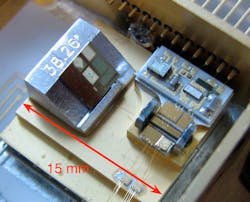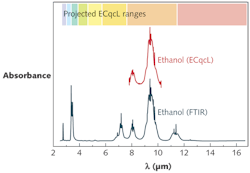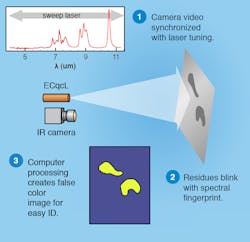SPECTROSCOPY: External-cavity QCLs broaden capabilities for molecular detection
MILES J. WEIDA, PETER BUERKI, ERIC TAKEUCHI, and TIMOTHY DAY
In the mid-infrared (IR) region, broad spectral coverage buys access to chemical "fingerprints," where molecules can be detected and distinguished with great sensitivity. New advances in external-cavity quantum-cascade lasers (QCLs) are enabling laser-based applications in an area once dominated by other techniques.
Mid-IR spectroscopy evolution
Mid-IR detectors and both dispersive and nondispersive spectrometers have been in use for more than 120 years, and the indispensable technique of Fourier transform infrared (FTIR) spectroscopy has existed for more than a half century. Even though these tools have been around long enough to qualify for senior benefits, they still remain the workhorses of mid-IR applications for one reason: They offer broad spectral coverage where most other techniques do not.
To understand why broad spectral coverage is so important, consider the absorption spectrum for acetone vapors (see Fig. 1). The strongest bands correspond to "skeletal" vibrations—bends, twists, and torsions of the whole molecular structure—excited when 5 to 20 µm mid-IR photons are absorbed by molecules. The skeletal vibration energies are unique for a given distribution of atomic masses and bonds in a molecule, creating a unique spectral absorption pattern or "fingerprint" for a molecule. Any spectroscopic technique that can capture this mid-IR spectral range has the ability to not only detect the concentration of molecules but to identify chemical components in a mixture as well.
Broadly tunable lasers provide definite advantages over the thermal sources used in older dispersive and FTIR spectrometers. The spectral brilliance is higher, enabling the use of less sensitive room-temperature detectors. The beam quality is better, allowing better coupling into optical fibers and novel sample interfaces. Higher powers and collimated beams enable stand-off detection geometries.
Until recently, the most promising broadly tunable mid-IR laser technology involved parametric frequency conversion.1 Periodically poled lithium niobate converts near-IR radiation out to the carbon hydrogen (CH) stretch region, and other nonlinear optical materials can generate tunable radiation out to 19 µm. However, the complexity and cost of these systems have kept them out of the broader commercial market. It is into this arena that a new semiconductor technology steps with the promise of compact, power- and cost-efficient broadly tunable lasers for the next generation of mid-IR spectrometers.
Quantum-cascade gain devices
Using the p-n junction in a diode as the gain medium has revolutionized the near-IR laser market. Unfortunately, attempts to push diode technology to longer wavelengths ran into the fundamental problem that thermal carriers swamp the diode junction as the bandgap decreases to accommodate mid-IR wavelengths. Hence, mid-IR lead-salt diode lasers require cryogenic cooling to operate.
The discovery of quantum-cascade devices offered a way to realize high-gain mid-IR lasers that not only could operate at room temperature but could be designed to provide wavelengths in a specific spectral region. Being semiconductor-based, QC devices can be made as small as diodes (see Fig. 2). Also, wall plug efficiencies in the tens of percent are predicted, meaning that power consumption and thermal management can be evenly matched with miniaturization potential.2External cavities realize QC potential
Semiconductor gain media can sport large gain bandwidths. A convenient metric for comparing media is the spread in energies available to support different laser wavelengths. For example, 596 cm-1 of gain bandwidth has been demonstrated in near-IR diodes and 444 cm-1 in mid-IR lead-salt diodes.3, 4 Quantum-cascade devices are no exception: Gain media with bandwidths of 432 cm-1 have been demonstrated.5
The most effective way to realize the full tuning potential of a broad gain bandwidth device is with an external cavity. One facet of the gain medium has an antireflection coating, and the laser cavity is formed externally with a frequency selective feedback element. Diffraction gratings are often used, but etalons, microelectromechanical systems (MEMS) devices, and other filters can be used to select and tune the wavelength. External cavity lasers can be miniaturized, leading to the mechanical and thermal stability necessary for robust, broadly tunable commercial devices in the mid-IR region.
The external cavity and mid-IR spectroscopy
The external-cavity QCL has been implemented in a variety of ways. Initial laboratory demonstrations and a recent demonstration of tuning from 7.6 to 11.4 µm have relied on large, macroscopic tuning assemblies.6 In contrast, Daylight Solutions has engineered compact external-cavity QCL (which it calls ECqcL) assemblies that provide the mechanical stability and portability necessary for commercial applications.
What is more pertinent to molecular detection, however, is the degree to which the ECqcL provides the laser solution for a new class of mid-IR spectrometers with broad spectral coverage. Consider the ethanol vapor absorption spectra captured with an FTIR spectrometer, and with an ECqcL spectrometer built by Daylight Solutions (see Fig. 3). The ECqcL spectrometer uses just one quantum-cascade device, yet covers a good portion of the fingerprint region from 7.8 to 10.2 µm. Moreover, the ECqcL spectrometer was built to demonstrate the advantages of this technology: It is battery powered, operates without cooling, and is able to acquire the full spectral sweep in less than 10 ms.The ECqcL can also cover the spectral region traditionally used by FTIR spectrometers. By extrapolating the highest achieved ECqcL tuning range of 432 cm-1 across the mid-IR, eight ECqcLs are required to match the FTIR region, and only three to cover the most significant portion of the fingerprint region. Given the ECqcL miniaturization efforts, it is not hard to imagine a commercially viable mid-IR spectrometer based on ECqcLs that is robust and compact.
Laser-based applications
The utility of FTIR spectrometers for molecular detection and chemical identification is undisputed. The use of lasers for a mid-IR spectrometer, however, opens up several new application possibilities.
For stand-off imaging of chemical residues, the higher powers and rapid tunability of the ECqcL are combined with a mid-IR camera to provide spectral imaging of residues (see Fig. 4). The ECqcL technology provides the speed, small size, and low power consumption needed for portable, real-time chemical imagers.In explosives detection, the directed nature of laser radiation makes remote discovery of explosives a reality. Here, ECqcLs have already been used to identify and quantify explosive residues at distances of up to 20 m.7 Combined with sensitive, inexpensive photoacoustic detection techniques, ECqcLs might provide a field-deployable sensor to help identify improvised explosive devices, or to pinpoint evidence of terrorist activity.
For mid-IR microscopy for tissue identification, FTIR microscopy is a powerful tool, with the ability to distinguish cancerous from healthy tissue.8, 9 But a typical FTIR microscope is a large bench-top instrument that requires liquid nitrogen to operate. Due to the relatively low intensity of the probe light from the thermal source, researchers in one study needed 40 minutes to acquire data for one screening.8 The goal is to make such tissue screening fast and available at a variety of locations. The intensity advantage from using an ECqcL for this application is so great that screening times could be reduced forty-fold. The higher intensity also allows for room-temperature imagers, removing the cumbersome need for liquid nitrogen. The compact nature of an ECqcL spectrometer also reduces overall instrument size and cost, making spectral imaging microscopes more viable medical tools.
As miniature gas detectors, FTIR spectrometers fall short. While they have been made as portable as possible for condensed-phased chemical sensing, their size is still too large for a wearable sensor: Instrument volumes of several liters and weights of several kilograms are common for the smallest FTIR sensors. Given the small size of the ECqcL, it is projected that a miniature spectrometer can be built that has a volume of 200 cm3—a wearable size. Miniature FTIR scanning mechanisms can provide at best 4 cm-1 resolution at scan speeds on the second time scale. In ECqcL spectrometers built at Daylight Solutions, resolutions of 0.2 cm-1 and scan speeds of <10 ms have been demonstrated. This type of resolution is necessary to adequately identify the different spectral components of gas samples, and the speed is necessary to "freeze" the sample during acquisition.
Many new gas detection applications need real-time sensitivity and specificity in a small form factor, such as in-vehicle passive monitoring for breath alcohol and personal hazardous gas monitoring in manufacturing. For these applications, ECqcLs have the spectral resolution, size, power, and speed necessary; in addition, the laser beam can be coupled into small-volume hollow-waveguide sample cells for a sensitive, miniature spectrometer. Each of these applications builds on the strong foundation of mid-IR spectrometry, extended by the exciting new technology of broad-tuning ECqcLs.
REFERENCES
- F.K. Tittel et al., Solid-State Mid-Infrared Laser Sources, Springer-Verlag, Berlin 89, p. 445–516 (2003).
- P.Q. Liu et al., Nature Photonics 4, p. 95–98 (2010).
- D. Wandt et al., Opt. Commun. 130, 1–3, p. 81–84 (1996).
- J. Butler et al., IEEE J. Quantum Electron. 19, 10, p. 1520–1525 (1983)
- A. Hugi et al., Appl. Phys. Lett. 95, 061103 (2009).
- G. Wysocki et al., Appl. Phys. B: Photophysics and Laser Chemistry 81, p. 769–777 (2005).
- C.W. Van Neste et al., Anal. Chem. 81, 5, p. 1952–1956 (2009).
- D.C. Fernandez et al., Nature Biotech. 23, 4, p. 469–474 (2005).
- M. Diem et al., Analyst 129, p. 880–885 (2004).
- S.W. Sharpe et al., Appl. Spectrosc. 58, 12, p. 1452–1461 (2004).
Miles J. Weida is a senior scientist, Peter Buerki is an application scientist, Eric Takeuchi is director of business development, and Timothy Day is CEO and CTO at Daylight Solutions, 13029 Danielson St., Poway, CA 92064; e-mail: [email protected]; www.daylightsolutions.com.
![FIGURE 1. The infrared (IR) absorption spectrum of acetone from a Fourier-transform IR (FTIR) spectrometer shows the chemical 'fingerprint' of strong absorptions from skeletal vibrations in the 5 to 20 µm region [10]. FIGURE 1. The infrared (IR) absorption spectrum of acetone from a Fourier-transform IR (FTIR) spectrometer shows the chemical 'fingerprint' of strong absorptions from skeletal vibrations in the 5 to 20 µm region [10].](https://img.laserfocusworld.com/files/base/ebm/lfw/image/2016/01/66836.png?auto=format,compress&fit=max&q=45&w=250&width=250)


